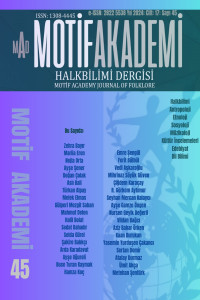Abstract
ÖZ: Sosyal hayatın neredeyse tüm alanlarında insanlar, sınıf, cinsiyet, bağlı oldukları gruplar, etnik köken, eğitim durumları vb. nedenlerden dolayı insanlar ya da insan dışı güçler tarafından kısıtlanmış gibi görünmektedir. Her ne kadar kimi zaman kanunlar, resmi kurumların uygulamaları ve somut biçimde gözlemlenemeyen sosyal kurumların dayattığı kısıtlayıcı mekanizmalarla mücadele etmek bir birey açısından kolay olmasa da insanın varlığı ve doğası her türlü baskıya karşı direnme eğiliminde olan bir güçtür. Nathaniel Hawthorne'un Kızıl Leke romanında kadın kahraman Hester Prynne, Püriten toplumunda hem baskının nesnesi hem de direnişin öznesi olarak kurgulanır. Romanda okuyucu, sembollerin yoğun kullanımı aracılığıyla toplumun bireyleri arasındaki güç ilişkilerine odaklanan izleklere maruz bırakılır. Sembollerin bolca kullanımı, Püriten toplumunda uygulanan fanatizm ile toplumun hem kadın hem de erkek üyeleri tarafından uygulanan şiddet ve katı bir şekilde şart koşulan cinsiyet rolleri arasında bir köprü oluştururken, okuyucunun ataerkil toplumun değerler sistemini, güç ve iktidar söylemini ve bunun ortaya koyduğu toplumsal cinsiyet rollerini sorgulamasını sağlıyor. Bu çalışmada Hester Prynne'in psikolojisine ve düşünsel yapısına ışık tutan Kızıl Leke romanında baskıcı dini otoriteyle ilişkilendirilebilecek sembol ve motifler incelenmiştir.
References
- Atwood, M. (2017). Damızlık kızın öyküsü. (çev.: Gökhan Sarı vd.), İstanbul: Doğan Kitap.
- Darwin, C. (2016). Tutkularımız en büyük zaaflarımızdır – aforizmalar. (çev.: Gökhan Sarı), İstanbul: Aylak Adam Kültür Sanat.
- Erdem, E. (2019). Eril tahakkümün distopyası damızlık kızın öyküsünün söylem analizi. Toplum ve Kültür Araştırmaları Dergisi, 3, 30-48.
- Genesis. (n.d.). in Bible (pp. 2:18, 21-24).
- Hawthorne, N. (1878). The scarlet letter. Boston: James R. Osgood and Company.
- Jordan, H. (2012). Uyandığında. (çev.: Özlem Yüksel), İstanbul: Yapı Kredi.
- Karakoç, M. (2016). Reading Sylvia Plath’s poetry through contemporary literary theory. İstanbul: İstanbul Aydın University Institute of Social Sciences Unpublished Doctoral Dissertation.
- Meyers, C. L. (1983). Gender roles and genesis 3: 16 revisited. The Word Of The Lord Shall Go Forth: Essays In Honor Of David Noel Freedman In Celebration Of His Sixtieth Birthday, 1, 337.
- Plath, S. (1992). The collected poems. (ed.: Ted Hughes), New York: Harper Perennial.
- Sanger, M. (1921). Birth control - past, present and future. Birth Control Review, 5, 5-6.
- Wang, Y. (2017). Ambiguous Hawthorne, symbolic pearl an analysis on pearl’s symbolism in the scarlet letter. 3rd International Conference on Social Science and Higher Education (ICSSHE-17). Atlantis Press.
Abstract
ABSTRACT: In almost all areas of social life, people seem to be constrained by something, due to their class, gender, group, ethnicity, education etc. Although it is not easy as an individual to fight against the restrictive mechanisms regulated by some official or social bodies, the very existence of human is a force that tends to resist any kind of oppression. In The Scarlet Letter by Nathaniel Hawthorne, the female protagonist, Hester Prynne, is depicted both as the object of oppression and subject of resistance in the Puritan society. In the novel, the reader is exposed to themes related to power relations among the members of the society through the extensive use of symbols. The excessive use of symbols seems to create a bridge between the fanaticism exerted in the Puritan society and the reader led to question the gender roles violently and strictly stipulated by the same members of the society, both females and males. In this study, the signs, symbols and motifs that can be associated with the oppressive authority in The Scarlet Letter, shedding light upon the psychology and intellect of Hester Prynne are examined.
References
- Atwood, M. (2017). Damızlık kızın öyküsü. (çev.: Gökhan Sarı vd.), İstanbul: Doğan Kitap.
- Darwin, C. (2016). Tutkularımız en büyük zaaflarımızdır – aforizmalar. (çev.: Gökhan Sarı), İstanbul: Aylak Adam Kültür Sanat.
- Erdem, E. (2019). Eril tahakkümün distopyası damızlık kızın öyküsünün söylem analizi. Toplum ve Kültür Araştırmaları Dergisi, 3, 30-48.
- Genesis. (n.d.). in Bible (pp. 2:18, 21-24).
- Hawthorne, N. (1878). The scarlet letter. Boston: James R. Osgood and Company.
- Jordan, H. (2012). Uyandığında. (çev.: Özlem Yüksel), İstanbul: Yapı Kredi.
- Karakoç, M. (2016). Reading Sylvia Plath’s poetry through contemporary literary theory. İstanbul: İstanbul Aydın University Institute of Social Sciences Unpublished Doctoral Dissertation.
- Meyers, C. L. (1983). Gender roles and genesis 3: 16 revisited. The Word Of The Lord Shall Go Forth: Essays In Honor Of David Noel Freedman In Celebration Of His Sixtieth Birthday, 1, 337.
- Plath, S. (1992). The collected poems. (ed.: Ted Hughes), New York: Harper Perennial.
- Sanger, M. (1921). Birth control - past, present and future. Birth Control Review, 5, 5-6.
- Wang, Y. (2017). Ambiguous Hawthorne, symbolic pearl an analysis on pearl’s symbolism in the scarlet letter. 3rd International Conference on Social Science and Higher Education (ICSSHE-17). Atlantis Press.
Details
| Primary Language | English |
|---|---|
| Subjects | Culture, Representation and Identity |
| Journal Section | Articles |
| Authors | |
| Publication Date | March 18, 2024 |
| Submission Date | February 10, 2024 |
| Acceptance Date | March 12, 2024 |
| Published in Issue | Year 2024 Volume: 17 Issue: 45 |



